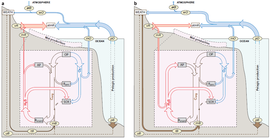Looking for a conection between the length of the Earth's days and the development of an oxygen-rich atmosphere.
[sciencythoughts.blogspot.com]
A day on Earth (i.e. the period between one sunrise and the next) lasts for 24 hours, but four billion years ago it may have been as short as six hours. Thus, the length of the day, and the length of time for which any given part of the Earth's surface is exposed to sunlight during each cycle has increased threefold over the history of the planet. The rate of photosynthesis (i.e. the rate at which oxygen is produced by Plants, Algae, and Cyanobacteria exposed to sunlight) is determined by instantaneous photon flux, and should not be affected by the length of the day, as long as the total amount of sunlight over any given period remains the same. However, the net rate of oxygen is influenced by both how much oxygen is produced, and the rate at which organic material (and the bio-available carbon it contains) is buried, and this burial rate is potentially influenced by the length of the day. Thus the net production of oxygen by benthic ecosystems will be influenced by changes in the length of the day, due to changes in the availability of metabolites, the import, export and accumulation of which can be sensitive to daylength.


Enjoy being online again!
Welcome to the community of good people who base their values on evidence and appreciate civil discourse - the social network you will enjoy.Create your free account
1 comment
Feel free to reply to any comment by clicking the "Reply" button.Recent Visitors 12
Notlost
Northeastern Oklahoma,
davknight
Swampwater,
waitingforgodo
Earth,
Fernapple
UK
Word
TX, USA
Photos 292 More
Posted by JoeBKite-like structures in the western Sahara Desert.
Posted by TriphidAn Aussie Indigenous Message Stick.
Posted by TriphidIndigenous Australian Aboriginal Rock art dated somewhere between 20 and 30 thousand years old.
Posted by TriphidIndigenous Australian Aboriginal Rock art dated somewhere between 20 and 30 thousand years old.
Posted by TriphidIndigenous Australian Aboriginal Rock art dated somewhere between 20 and 30 thousand years old.
Posted by TriphidIndigenous Australian Aboriginal Rock art dated somewhere between 20 and 30 thousand years old.
Posted by JoeBDortoka vremiri: A new species of Dortokid Turtle from the Late Cretaceous of the Hațeg Basin, Romania.
Posted by JoeBThe Cabeço da Amoreira burial: An Early Modern Era West African buried in a Mesolithic shell midden in Portugal.
Posted by JoeBMusivavis amabilis: A new species of Enantiornithine Bird from the Early Cretaceous Jehol Biota of northeastern China.
Posted by JoeBTorosaurus in Canada.
Posted by JoeBStone tools from the Borselan Rock Shelter, in the Binalud Mountains of northeastern Iran.
Posted by JoeBDating the Lantian Biota.
Posted by JoeBBashanosaurus primitivus: A new species of Stegosaur from the Middle Jurassic of Chongqing Municipality, China.
Posted by JoeBDetermining the time of year when the Chicxulub Impactor fell.
Posted by JoeBSão Tomé and Príncipe: Possibly the last country on Earth never to have been visited by a working archaeologist.
Posted by JoeBMambawakale ruhuhu: A new species of Pseudosuchian Archosaur from the Middle Triassic Manda Beds of Tanzania.






